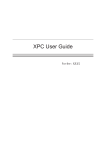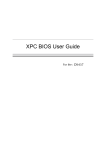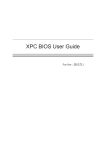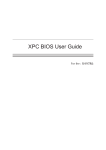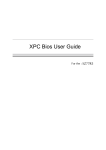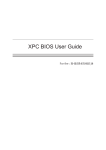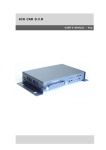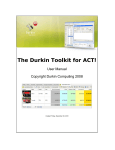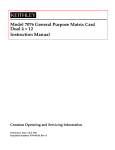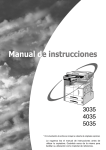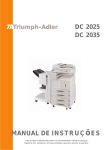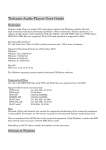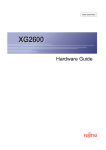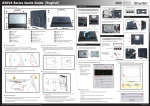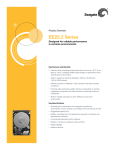Download XPC BIOS User Guide
Transcript
XPC BIOS User Guide For the : X50V4 Shuttle® XPC Installation Guide Copyright ©2014 by Shuttle® Inc. All Rights Reserved. No part of this publication may be reproduced, transcribed, stored in a retrieval system, translated into any language, or transmitted in any form or by any means such as electronic, mechanical, magnetic, optical, chemical, photocopy, manual, or otherwise, without prior written permission from Shuttle® Inc. Other brands and product names used herein are for identification purposes only and may be trademarks of their respective owners. Disclaimer Shuttle® Inc. shall not be liable for any incidental or consequential damages resulting from the performance or use of this product. Shuttle® Inc. makes no representation or warranty regarding the contents of this manual. Information in this manual had been carefully checked for accuracy;however, no guarantee is given as to the correctness of the contents. For continuing product improvement, Shuttle® Inc. reserves the right to revise the manual or make changes to the specifications of this product at any time without notice and obligation to any person or entity regarding such change. The information contained in this manual is provided for general use by customers. This device complies to Part 15 of the FCC Rules. Operation is subject to the following two conditions: 1.This device may not cause harmful interference. 2.This device must withstand any background interference including those that may cause undesired operation. Trademarks Shuttle is a registered trademark of Shuttle Inc. Intel and Pentium are registered trademarks of Intel Corporation. PS/2 is a registered trademark of IBM Corporation. AWARD is a registered trademark of Award Software Inc. Microsoft and Windows are registered trademarks of Microsoft Corporation. General Notice Other brand and product names used herein are for identification purposes only and may be trademarks of their respective owners. Safety Information Read the following precautions before setting up a Shuttle XPC. CAUTION Incorrectly replacing the battery may damage this computer. Replace only with the same or equivalent as recommended by Shuttle. Disposal of used batteries according to the manufacturer's instructions. Laser compliance statement The optical disc drive in this server is a laser product. The drive's classification label is lacated on the drive. CLASS 1 LASER PRODUCT CAUTION:NVISIBLE LASER RADIATION WHEN OPEN. AVOID EXPOSURE TO BEAM. Installation Notices Do not place this device underneath heavy loads or in an unstable position. Do not use or expose this device around magnetic fields as magnetic interference may affect the performance of the device. Do not expose this device to high levels of direct sunlight, highhumidity or wet conditions. Do not block the air vents to this device or impede the airflow in any way. TABLE OF CONTENTS Driver and Software Installation........................................................1 Motherboard Driver DVD.......................................................1 User Manuals.........................................................................2 Appendix...........................................................................................3 Starting BIOS..............................................................................3 BIOS Setup Menu.......................................................................3 Main Setup.....................................................................5 Advanced........................................................................6 CPU Configuration....................................................7 SATA Configuration..................................................9 USB Configuration..................................................10 Onboard Device Configuration................................11 Power Management Configuration..........................13 Hardware Health Configuration...............................15 Boot..............................................................................16 Security.........................................................................18 Save & Exit...................................................................20 English Driver and Software Installation Motherboard Driver DVD The DVD contents attached in X50V4 Series motherboard are subject to change without notice. The Motherboard Driver DVD contains all the motherboard drivers necessary to optimize the performance of this Shuttle Xvision in a Windows® OS. Install these drivers after installing Microsoft® Windows®. Insert the attached DVD into your DVD-ROM drive. The DVD AutoRun screen should appear. If the AutoRun screen does not appear, double click on Autorun icon in My Computer to bring up Shuttle Mainboard Software Setup screen. Navigation Bar Description : Auto Install Driver/Utility Install Touch Panel Device User Manuals - Motherboard Manual, Quick Guide. Link To Shuttle Website - Link to shuttle website homepage. Browse This DVD - Allows you to see contents of this DVD. English User Manuals Install Adobe Reader 9.5 Motherboard Manual Quick Guide English Appendix Starting BIOS AMIBIOS has been integrated into many motherboards for over a decade. In the past, people often referred to the AMIBIOS setup menu as BIOS, BIOS setup, or CMOS setup. American Megatrends refers to this setup as BIOS. Specifically, it is the name of the AMIBIOS BIOS setup utility. This chapter describes the basic navigation of the BIOS setup screens. Enter the BIOS To enter the BIOS setup screens, follow the steps below: Step1. Power on the motherboard. Step2. Press the <Delete> key on your keyboard when you see the following text prompt: Press DEL to run Setup. Step3. After you press the <Delete> key, the main BIOS setup menu displays. You can access the other setup screens from the main BIOS setup menu, such as the Chipset and Power menus. This manual describes the standard look of the BIOS setup screen. The motherboard manufacturer has the ability to change any and all of the settings described in this manual. This means that some of the options described in this manual do not exist in your motherboard's AMIBIOS. In most cases, the <Delete> key is used to invoke the BIOS setup screen. There are a few cases that other keys are used, such as <F1>,<F2>, and so on. BIOS Setup Menu The main BIOS setup menu is the first screen that you can navigate. Each main BIOS setup menu option is described in this user’s guide. The Main BIOS setup menu screen has two main frames. The left frame displays all the options that can be configured. “Grayed-out” options cannot be configured. Options is blue can be. The right frame displays the key legend. Above the key legend is an area reserved for a text message. When an option is selected in the left frame, it is highlighted in white. Often a text message will accompany it. English AMIBIOS has default text messages built into it. The motherboard manufacture retains the option to include, leave out, or change any of these text messages. They can also add their own text messages. Because of this, many screen shots in this manual are different from your BIOS setup screen. The BIOS setup/utility uses a key-based navigation system called hot keys. Most of the BIOS setup utility hot keys can be used at any time during the setup navigation process. These keys include <F1>, <F4>, <Enter>, <ESC>, <Arrow> keys, and so on. There is a hot key legend located in the right frame on most BIOS setup screens. Hot Key Description → Left ← Right The Left and Right <Arrow> keys allow you to select a BIOS setup screen. For example: Main screen, Advanced screen, Chipset screen, and so on. ↑ Up ↓ Down The Up and Down <Arrow> keys allow you to select an BIOS setup item or subscreen. +- Plus/Minus The Plus and Minus <Arrow> keys allow you to change the field value of a particular setup item. For example: Date and Time. Tab The <Tab> key allows you to select BIOS setup fields. F1 The <F1> key allows you to display the General Help screen. Press the <F1> key to open the General Help screen. F4 The <F4> key allows you to save any changes you have made and exit BIOS Setup. Press the <F4> key to save your changes. Press the <Enter> key to save the configuration and exit. You can also use the <Arrow> key to select Cancel and then press the <Enter> key to abort this function and return to the previous screen. ESC The <Esc> key allows you to discard any changes you have made and exit the BIOS Setup. Press the <Esc> key to exit the BIOS setup without saving your changes. Press the <Enter> key to discard changes and exit. You can also use the <Arrow> key to select Cancel and then press the <Enter> key to abort this function and return to the previous screen. Enter The <Enter> key allows you to display or change the setup option listed for a particular setup item. The <Enter> key can also allow you to display the setup subscreens. English Main Setup When you first enter the BIOS Setup Utility, you will enter the Main setup screen. You can always return to the Main setup screen by selecting the Main tab. There are two Main Setup options. They are described in this section. The Main BIOS Setup screen is shown below. System Time/System Date Use this option to change the system time and date. Highlight System Time or System Date using the <Arrow> keys. Enter new values through the keyboard. Press the <Tab> key or the <Arrow> keys to move between fields. The date must be entered in MM/DD/YY format. The time is entered in HH:MM:SS format. The time is in 24-hour format. For example, 5:30 A.M. appears as 05:30:00, and 5:30 P.M. as 17:30:00. English Advanced Select the Advanced tab from the BIOS setup screen to enter the Advanced BIOS Setup screen. You can select any of the items in the left frame of the screen, such as CPU Configuration, to go to the sub menu for that item. You can display an Advanced BIOS Setup option by highlighting it using the <Arrow> keys. All Advanced BIOS Setup options are described in this section. The Advanced BIOS Setup screen is shown below. The sub menus are described on the following pages. English CPU Configuration You can use this screen to select options for the CPU Configuration Settings. Use the up and down <Arrow> keys to select an item. Use the <Plus> and <Minus> keys to change the value of the selected option. A description of the selected item appears on the right side of the screen. The settings are described on the following pages. An example of the CPU Configuration screen is shown below. The CPU Configuration setup screen varies depending on the installed processor. English Intel(R) V. T. When enable, a VMM can utilize the additional hardware capabilities provided by vanderpool Technology. The choice: Enabled , Disabled. CPU support, item appear. Active Processor Cores This item allows you to determine how many cores to be enabled. The choice: ALL,1. EIST This item allows you to enable or disable Enhanced lntel SpeedStep® Technology. The choice: Enabled , Disabled. C State Support This item allows you to enable or disable CPU C State. The choice: Enabled , Disabled. English SATA Configuration Hot Plug This item allows you to enable or disable Hot Plug capability. The choice: Enabled , Disabled. English USB Configuration USB 3.0 Controller This item allows you to enable or disable USB 3.0 Controller. The choice: Enabled , Disabled. 10 English Onboard Device Configuration High Definition Audio This item allows you to enable or disable system High Definition Audio. The choice: Enabled , Disabled. Onboard LAN Function(+SD Card) This item allows you to enable or disable LAN Function. The choice: Enabled , Disabled. Onboard LAN BOOT ROM This item allows you to enable or disable Onboard LAN BOOT ROM. The choice: Enabled , Disabled. IGD Memory Size Select Allows you to select the size of system memory used by the internal graphics device. The choice: 64MB, 128MB, 256MB, 512MB, 1024MB. 11 English Serial Port Configuration Controller Option are in its sub-menu. Press<Enter>to enter the sub-menu of detailed options. Serial Port 1 This item allows you to enable or disable Serial Port. The choice:Enabled, Disabled. 12 English Power Management Configuration Suspend mode Select the highest ACPI Sleep state the system will enter when the SUSPEND button is pressed. The choice: S1 (POS), S3 (STR). Wake Up By USB (S3) This item allows you to enable or disable system wake up by USB (S3). The choice: Enabled , Disabled. EuP Function This item allows you to enable or disable system EuP function in S4/S5. The choice: Enabled , Disabled. PowerOn after Power-Fail This item allows you to set system power on automatically after AC power restored. The choice:Power On, Former-sts, Power Off, Power On by LAN, Power On by RTC. 13 English Wake Up By LAN This item allows you to enable or disable system wake on by onboard LAN chip. The choice: Enabled , Disabled. PowerOn by RTC Alarm When enabled, System will wake on the hr::min::sec specified. The choice: Enabled , Disabled. 14 English Hardware Health Configuration 15 English Boot Select the Boot tab from the BIOS setup screen to enter the Boot BIOS Setup screen. You can select any of the items in the left frame of the screen, such as Boot Settings Configuration, to go to the sub menu for that item. You can display an Boot BIOS Setup option by highlighting it using the <Arrow> keys. All Boot BIOS Setup options are described in this section. The Boot BIOS Setup screen is shown below. The sub menus are described on the following pages. Bootup Num-Lock This item allows you to enable or disable keyboard Num-Lock state. The choice: Enabled, Disabled. Boot from USB device Enabled/Disabled onboard USB storage boot function. The choice: Enabled, Disabled. 16 English Boot from Card-Reader Enabled/Disabled onboard Card-Reader boot function. The choice: Enabled, Disabled. Boot mode select Choice Boot ro UEFI or Legacy. The choice: LEGACY, UEFI. Boot Device Priority (Boot Option #1/2/3/....) Specifies the boot sequence from the available devices. A device enclosed in parenthesis has been disabled in the corresponding type menu. 17 English Security Select the Security tab from the BIOS setup screen to enter the Security BIOS Setup screen. You can display an Security BIOS Setup option by highlighting it using the <Arrow> keys. All Security BIOS Setup options are described in this section. The Security Setup screen is shown below. The sub menus are documented on the following pages. Supervisor Password Indicates whether a supervisor password has been set. If the password has been installed, Installed displays. If not, Not Installed displays. User Password Indicates whether a user password has been set. If the password has been installed, Installed displays. If not, Not Installed displays. Change Supervisor Password Select Change Supervisor Password from the Security Setup menu and press <Enter>. Enter New Password: 18 Change User Password Select Change User Password from the Security Setup menu and press <Enter>. Enter New Password: appears. Type the password and press <Enter>. The screen does not display the characters entered. Retype the password as prompted and press <Enter>. If the password confirmation is incorrect, an error message appears. The password is stored in NVRAM after BIOS completes. Flash Write Protection Choose [Enabled] to avoid virus destroy BIOS. If you want to flash BIOS, you must set it [Disabled]. The choice: Enabled or Disabled. Secure Boot Control This item allows user to enable/disable Secure Boot function. 19 English appears. Type the password and press <Enter>. The screen does not display the characters entered. Retype the password as prompted and press <Enter>. If the password confirmation is incorrect, an error message appears. The password is stored in NVRAM after BIOS completes. English Save & Exit Select the Exit tab from the BIOS setup screen to enter the Exit BIOS Setup screen. You can display an Exit BIOS Setup option by highlighting it using the <Arrow> keys. All Exit BIOS Setup options are described in this section. The Exit BIOS Setup screen is shown below. 20 English Save Changes and Exit When you have completed the system configuration changes, select this option to leave BIOS Setup and reboot the computer so the new system configuration parameters can take effect. Select "Save Changes and Exit" from the Exit menu and press <Enter>. Save Configuration Changes and Exit Now? [Ok] [Cancel] appears in the window. Select Ok to save changes and exit. Exit Without Saving Changes Select "Exit without Saving Changes" from the Exit menu and press <Enter>. Select Ok to discard changes and Exit. Load Defaults Settings BIOS automatically sets all BIOS Setup options to a complete set of default settings when you Select this option. The Optimal settings are designed for maximum system performance, but may not work best for all computer applications. In particular, do not use the Optimal BIOS Setup options if your computer is experiencing system configuration problems. Select Load Optimal Defaults from the Exit menu and press <Enter>. Select Ok to load optimal defaults. 21

























